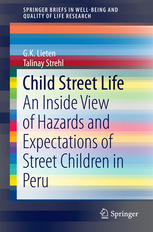Child Street Life: An Inside View of Hazards and Expectations of Street Children in Peru

As a brief overview, Child Street Life is most useful for readers new to the topic, or those particularly interested in Peru. Controversially, the book argues that the discourse on street children has shifted too far from the traditional protection focus to a preoccupation with children’s agency. The authors see this more recent approach as neglecting the dismal reality of street life, which is in danger of being romanticized.
The argument proceeds from a brief conceptual discussion to an explanation of the fieldwork. The conceptual section outlines the difficulty of determining who is a street child and how many such children there are. This is not a fixed category, and reliable statistics are very difficult to obtain. Other issues that pop up when discussing street children are the label itself, which some feel is stigmatizing, and the debate about whether child labour should be regulated or abolished outright.
Peru is a useful case for a study of street children as ¾ of the country’s population is urban and ¼ of Peruvian children live in extreme poverty (as defined by UNICEF). The research team interviewed 1,100 children living or working in two Peruvian cities, Lima and Cusco. The majority of these children (pejoratively called pirañas) usually stayed with their parents, and girls were a distinct minority. Even among those living on the streets, most reported going to see their families occasionally.
Reasons for leaving home were varied. Push factors included poverty, abuse, and family dysfunction, while pull factors included the independence and freedom of living alone in the city. Interestingly, there was a strong association between children being sent out to work on the streets and deciding to live there. Most of the respondents had stayed in an institution at some point, whether a more restrictive children’s home or a more permissive shelter.
The most common economic activity reported by the children was selling goods on the street. Many also engaged in petty thievery, whether out of necessity (due to an inability to find formal work) or a sense of injustice (seeing the rich and/or tourists as unfairly privileged).
Meanwhile, the problems associated with street life that these children reported included violence (commonly from the police and security officers) and drug use (the majority of those living on the street used intoxicants like alcohol, glue, marijuana and cocaine paste). Education was another concern; 16 per cent of respondents living on the street were attending school, compared to 77 per cent of those working on the street while living with relatives. And a universal problem reported by the study participants was the feeling of marginalization. Fifteen-year-old Hector, for instance, told an interviewer:
I don’t love myself, because I do many bad things. But my brain is already damaged. I take drugs, I have so many vices. Who wants to talk with a boy like me? I didn’t study, I have no money. I have never done anything useful in life. I was never been loved by someone. For me - my life is worth nothing.
From these and other findings, the authors call for enhanced responses at the governmental and nongovernmental levels. There should be more coordination between civil society organizations working with street children, as well as more attention to the children’s longer-term needs. The police force should be less combative and more understanding of street children’s situations. And in addition to these reactive steps, prevention should be sought through investments in rural education and poverty alleviation.
Further reading:
Bibars, Iman (1998), “Street children in Egypt: from the home to the street to inappropriate corrective institutions”, Environment and Urbanization Vol 10, No 1, pages 201–216, available at http://eau.sagepub.com/content/10/1/201.abstract.
Conticini, Alessandro (2005), “Urban livelihoods from children’s perspectives: protecting and promoting assets on the streets of Dhaka”, Environment and Urbanization Vol 17, No 2, pages 69–81, available at http://eau.sagepub.com/content/17/2/69.abstract.
Leite, Ligia Costa and Martha de Abreu Esteves (1991), “Escola Tia Ciata - a school for street children in Rio de Janeiro”, Environment and Urbanization Vol 3, No 1, pages 130–139, available at http://eau.sagepub.com/content/3/1/130.abstract.
Patel, Sheela (1990), “Street Children, hotel boys and children of pavement dwellers and construction workers in Bombay - how they meet their daily needs”, Environment and Urbanization Vol 2, No 2, pages 9–26, available at http://eau.sagepub.com/content/2/2/9.abstract.
Book note prepared by Christine Ro
Search the Book notes database
Our Book notes database contains details and summaries of all the publications included in Book notes since 1993 - with details on how to obtain/download.
Use the search form above, or visit the Book notes landing page for more options and latest content.
For a searchable database for papers in Environment and Urbanization, go to http://eau.sagepub.com/

